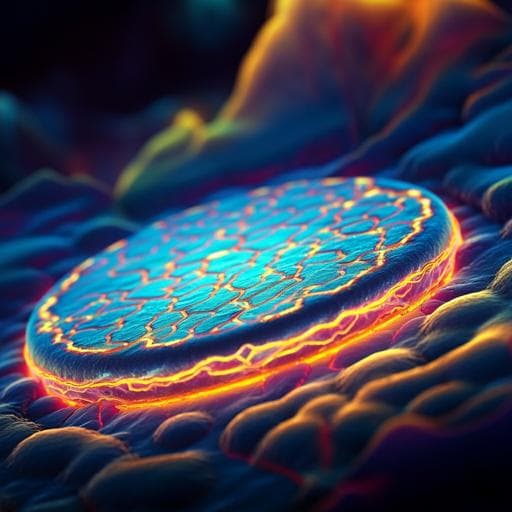
Engineering and Technology
Tackling realistic Li⁺ flux for high-energy lithium metal batteries
S. Zhang, R. Li, et al.
This groundbreaking research by Shuoqing Zhang and colleagues reveals a new mechanistic model for optimizing Li metal batteries by enhancing the solid electrolyte interphase. The study highlights the critical relationship between Li⁺ mobility and capacity loss, paving the way for the design of more efficient electrolytes that promise improved performance for LMBs.
~3 min • Beginner • English
Introduction
Lithium metal batteries (LMBs) promise >350 Wh kg⁻¹ due to the Li metal anode’s high specific capacity and low redox potential, but practical deployment is hindered by dendritic Li growth and low Coulombic efficiency arising from unstable, non-uniform solid electrolyte interphases (SEI). Although LiF-rich SEIs—enabled by fluorinated electrolytes, additives, and high/localized high-concentration electrolytes—provide low electronic conductivity and high surface energy beneficial for suppressing dendrites, LiF’s poor Li⁺ conductivity (∼10⁻¹⁰ S cm⁻¹) induces non-uniform Li⁺ flux and kinetically driven dendritic deposition. Classical Sand’s time analysis describes dendrite onset via bulk electrolyte concentration polarization but neglects Li⁺ migration through the SEI, often the rate-limiting step, and requires unrealistically high current densities in practical cells. Therefore, a model that integrates SEI-controlled Li⁺ transport with bulk electrolyte effects is needed. This work proposes such a mechanistic protocol, aiming to quantify how SEI properties govern Li deposition, and to guide electrolyte design to homogenize Li⁺ flux (e.g., via dual-halide SEI) and achieve high CE with dendrite-free plating.
Literature Review
Prior strategies emphasized constructing LiF-rich SEIs via fluorinated solvents, additives, high-concentration (HCE) and localized HCE electrolytes to improve CE (>99%). LiF’s high surface energy and mechanical characteristics are beneficial, yet its high Li⁺ diffusion barrier results in heterogeneous Li⁺ flux. The Sand’s time framework and related growth models describe dendrite initiation from cation depletion in bulk electrolytes but omit SEI transport resistance, limiting applicability under practical conditions where limiting current is not reached. Empirical observations link higher bulk ionic conductivity to lower SEI impedance. Collectively, literature highlights the promise of fluorine-rich interphases while revealing the unresolved kinetic role of SEI Li⁺ transport in driving non-uniform deposition.
Methodology
Modeling and theory: The SEI is approximated into regions of high and low Li⁺ mobility, and Li deposition is modeled via Li mass conservation, yielding a linear relation between capacity loss Qloss and applied current density j. The slope k (0–1) reflects Li⁺ flux homogeneity across the SEI (lower k → more homogeneous), while the intercept Qir captures irreversible losses (dead Li and SEI formation) and sets the maximum attainable CE via CEmax = (Qtotal − Qir)/Qtotal. An equivalent circuit captures Li⁺ diffusion across bulk electrolyte and SEI. COMSOL multiphysics simulations visualize Li⁺ concentration and potential distributions across electrolyte and SEI for different electrolytes/SEIs. Assumptions include uniform, stable SEI coverage with constant thickness and ionic conductivity during deposition.
Electrolyte design: A dual-halide electrolyte (1.3 M LiFSI in DME/1,2-dichloroethane, DCE; termed 1.3 M LDC) is formulated to in situ form a dual-halide LiF1−xClx-rich SEI, targeting enhanced Li⁺ mobility (lower migration barriers) without sacrificing mechanical integrity. Comparative electrolytes include commercial baseline EC/DMC with 1 M LiPF6 (BE), 1.3 M LiFSI in DME (LCE), 6 M LiFSI in DME (HCE), and other fluorinated cosolvent systems.
Solvation and interphase characterization: Raman spectroscopy probes Li⁺ solvation. Molecular dynamics (MD) simulations (OPLS-AA force field; NpT then NVT at 298 K) analyze solvation shell composition, ion pairing/clustering, radial distribution functions, and visualize solvation structures. XPS depth profiling (F 1s, Cl 2p, C 1s, Li 1s) identifies SEI composition and halide incorporation.
Transport calculations: DFT (PBE-PAW with D3 dispersion) computes Li binding energy landscapes and NEB energy barriers for surface/grain-boundary diffusion on LiF and Cl-doped LiF1−xClx, as well as other SEI components (Li2O, Li2CO3, Li3N). MD simulations evaluate bulk Li⁺ diffusion in LiF and LiF1−xClx supercells across 1750–2500 K; diffusion coefficients are extracted via Einstein’s relation and activation energies via Arrhenius analysis.
Electrochemistry: Li||Cu cells assess CE by Aurbach’s method and by repeated plating/stripping (0.5 mA cm⁻², 1 mAh cm⁻²). Nucleation and growth overpotentials are derived from voltage profiles during plating. Morphology is examined by SEM; thickness of deposits measured after fixed capacity deposition. Li||Li symmetric cells evaluate long-term stability and EIS monitors SEI Li⁺ mobility resistance (R1) versus time. Full cells (Li||NCM811, Li||LCO) with thin Li (20 µm) and high-loading cathodes test cycle life and rate capability; anode-free Cu||NCM523 pouch cells (180 mAh) assess practical performance (0.3C/0.6C).
Key Findings
- A linear correlation between capacity loss (Qloss) and current density (j) holds across multiple state-of-the-art electrolytes, validating the model. The slope k quantifies Li⁺ flux homogeneity across the SEI; the intercept Qir sets CEmax.
- Extracted parameters: BE shows low k (1.742) but high Qir (3.825 mAh cm⁻²), indicating poor CE; several fluorinated systems (e.g., HCE and others) show high k (e.g., HCE k = 15.410), consistent with LiF-rich SEIs imposing high Li⁺ diffusion barriers and heterogeneous flux at high plating capacity.
- The dual-halide electrolyte (1.3 M LDC; DME/DCE) yields the lowest k (0.533), the smallest Qir (0.232 mAh cm⁻²), and the highest CEmax (99.75%) among tested electrolytes, indicating highly uniform Li⁺ transport across a LiF1−xClx-rich SEI.
- Solvation structure in 1.3 M LDC is AGG-dominated with average Li⁺ shell composition FSI:DME:DCE ≈ 2.67:1.02:0.02; FSI/DME ratios of 3:1 and 2:1 account for 45% and 29% of shells; FSI-centered clusters with ≥2 adjacent Li⁺ occur in 90% of cases. DCE weakly coordinates Li⁺, favoring anion-derived interphases.
- XPS confirms dual-halide SEI: LiF from FSI decomposition with Cl-containing species from DCE; Li 1s shows LiX (X = F, Cl). In BE, POxFy and organic species dominate, implying less protective SEI and HF generation.
- DFT/MD transport: Li⁺ surface/grain-boundary diffusion barriers on LiF (0.18 and 0.23 eV) are reduced to 0.03 and 0.09 eV with Cl doping in LiF1−xClx (∼10% Cl), enlarging low-binding-energy pathways and flattening energy landscapes. Bulk Li⁺ diffusion coefficients and activation energies are similar for LiF and LiF1−xClx, indicating grain-boundary transport dominates SEI Li⁺ flux control.
- Electrochemical metrics (Li||Cu): CE by Aurbach’s method—BE 86.93%, LCE 98.15%, HCE 99.31%, LDC 99.54%. Repeated plating/stripping CE stabilizes at 99.46% in LDC (>99.3% by 50 cycles), vs 99.26% in HCE.
- Nucleation overpotential ηn is reduced in LDC (88 mV) versus BE (184 mV) and HCE (121 mV), enabling larger nuclei and flatter growth. Growth-region plateau overpotential in LDC is lower (≈50 mV) and stable upon cycling.
- Morphology: LDC yields dense, dendrite-free, large nodule-like Li deposits; deposited thickness at 4 mAh cm⁻² is 23 µm (near theoretical 20 µm), versus 44 µm in HCE.
- Symmetric Li||Li cells with LDC remain stable over 1500 h; BE and HCE exhibit rising overpotentials and short circuits within <1000 h. EIS shows smaller and more stable SEI Li⁺ mobility resistance (R1) in LDC than HCE over 96 h rest.
- Full-cell performance: With high-loading NCM811 (23.7 mAh cm⁻²) and thin Li (20 µm; N/P ≈ −1), LDC enables >200 cycles; BE and LCE fail within 60 cycles; HCE ≈130 cycles. LCO (2 mAh cm⁻², N/P = 2) with LDC delivers 180 mAh g⁻¹ initially and 80% retention after 240 cycles. Even with DMC-based solvent (2.2 M LiFSI/DMC-DCE, N/P ≈ −1), >150 cycles are maintained.
- Anode-free Cu||NCM523 pouch cells (180 mAh, 0.3C/0.6C) achieve 125 cycles with 70% capacity retention and minimal gassing in LDC; HCE fails rapidly.
- Cathode interphase: LDC forms compact, inorganic-rich CEI on NCM811 (thin ∼2 nm layer), preserving structural integrity and lowering impedance growth compared with BE.
Discussion
The study quantifies the kinetic role of SEI-controlled Li⁺ transport in lithium deposition by introducing a linear Qloss–j relationship whose slope k captures Li⁺ flux homogeneity and whose intercept Qir limits attainable CE. Analysis across leading fluorinated electrolytes shows that LiF-rich SEIs, despite stabilizing interfaces electronically and mechanically, often impose high Li⁺ diffusion barriers that promote heterogeneous flux and dendritic growth at practical areal capacities. Guided by the model, engineering SEI chemistry to reduce and homogenize Li⁺ migration barriers—via in situ formation of a dual-halide LiF1−xClx-rich SEI—substantially homogenizes Li⁺ flux (low k), reduces nucleation and growth overpotentials, and yields dense, near-theoretical-thickness deposits. These interfacial improvements translate to high CE in half cells, long-lived symmetric cells, and durable, high-loading full cells, including anode-free pouch cells under practical conditions. The findings demonstrate that optimizing SEI Li⁺ mobility at grain boundaries is pivotal for dendrite suppression and that the k–Qir framework provides a practical metric to evaluate electrolyte–anode compatibility.
Conclusion
A mechanistic protocol linking SEI properties to Li deposition is established, defining an indicator (k/κ) for Li⁺ flux homogeneity and an intercept Qir that sets CEmax. This framework accurately evaluates diverse electrolytes and motivates a dual-halide electrolyte (1.3 M LiFSI in DME/DCE) that forms a LiF1−xClx-rich SEI. Cl incorporation markedly lowers grain-boundary Li⁺ diffusion barriers while maintaining mechanical robustness, enabling CE up to 99.54% in Li||Cu cells, dendrite-free dense plating, long-lived symmetric cells, >200-cycle high-loading full cells with thin Li, and 125-cycle anode-free pouch cells with 70% retention. The protocol offers a generalizable route to design and benchmark electrolytes for practical LMBs by targeting uniform, low-barrier Li⁺ transport across SEIs. Potential future directions include tuning halide content/chemistry and broadening the approach to other interphase compositions and solvent systems.
Limitations
The modeling and simulations assume a uniformly and stably covering SEI with constant thickness and ionic conductivity during deposition. The SEI is approximated into high- and low-mobility zones via an equivalence approximation. Bulk diffusion coefficients for LiF/LiF1−xClx are extracted from high-temperature MD and extrapolated via Arrhenius relations. Performance evaluations and parameter extraction focus on selected fluorine-rich electrolyte systems under defined testing conditions.
Related Publications
Explore these studies to deepen your understanding of the subject.







